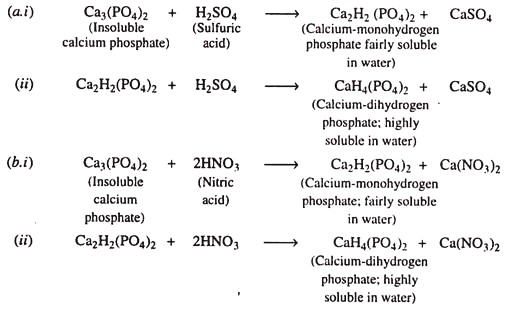ADVERTISEMENTS:
Phosphorus is one of the most important constituent of several important compounds always present in organisms. It occurs both in organic (nucleic acids, nucleoproteins, phospholipids, etc.) and inorganic (phosphate) forms in the living organisms. Animals possessing bones have large amount of phosphorus in its inorganic form.
However, phosphorus is added to soil through chemical fertilizers, excrete and organism- residues. Though there is plenty of phosphorus present in the soil in unavailable inorganic forms, most of the plants obtain it only as orthrophosphate ions (soluble inorganic forms). However, mycorrhizae, when present, help the plants in obtaining phosphorus.
The cycle of phosphorus is schematically represented in Fig. 30.5 and can be well studied under following two heads:
ADVERTISEMENTS:
1. Mineralization: Conversion of Organic Phosphorus into Insoluble Inorganic Phosphates:
Many soil microorganisms produce enzymes that attack many of the organic phosphorus compounds in the soil and release inorganic phosphate. This process is comparable to the mineralization of organic nitrogen compounds. The enzymes involved in these reactions are collectively called ‘phosphatases’ which have a broad range of substrate specificity.
2. Solubilization: Conversion of Insoluble Inorganic Phosphates into Soluble Inorganic Phosphates:
ADVERTISEMENTS:
The availability of phosphorus depends on the degree of solubilization by various organic and inorganic acids produced by microorganisms in soil. These are the solubilized form of insoluble inorganic phosphates which are taken in by the plants.
Fungi, e.g., Aspergillus, Penicillium, Fusarium are the most important of the soil microorganisms which produce substantial amounts of these acids; others are the bacteria, namely, Bacillus, Pseudomonas, Micrococcus, Flavobacterium, etc.
The overall conversion of insoluble inorganic phosphates into soluble inorganic phosphates by the action of acids can be exemplified via reactions as under:
ADVERTISEMENTS:
ADVERTISEMENTS:
The action of acids to convert insoluble phosphates into soluble ones is generally called ‘solubilization’ and particularly takes place in close proximity of the root surfaces where sugar from root-exudates are converted by the action of microorganisms into organic acids.

